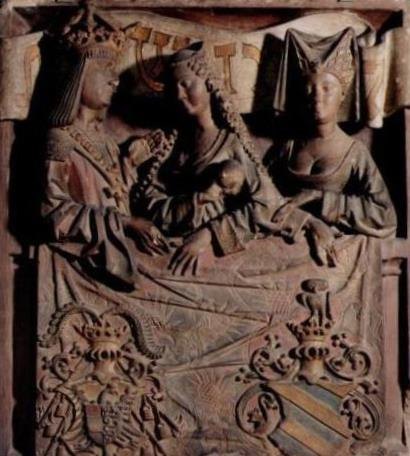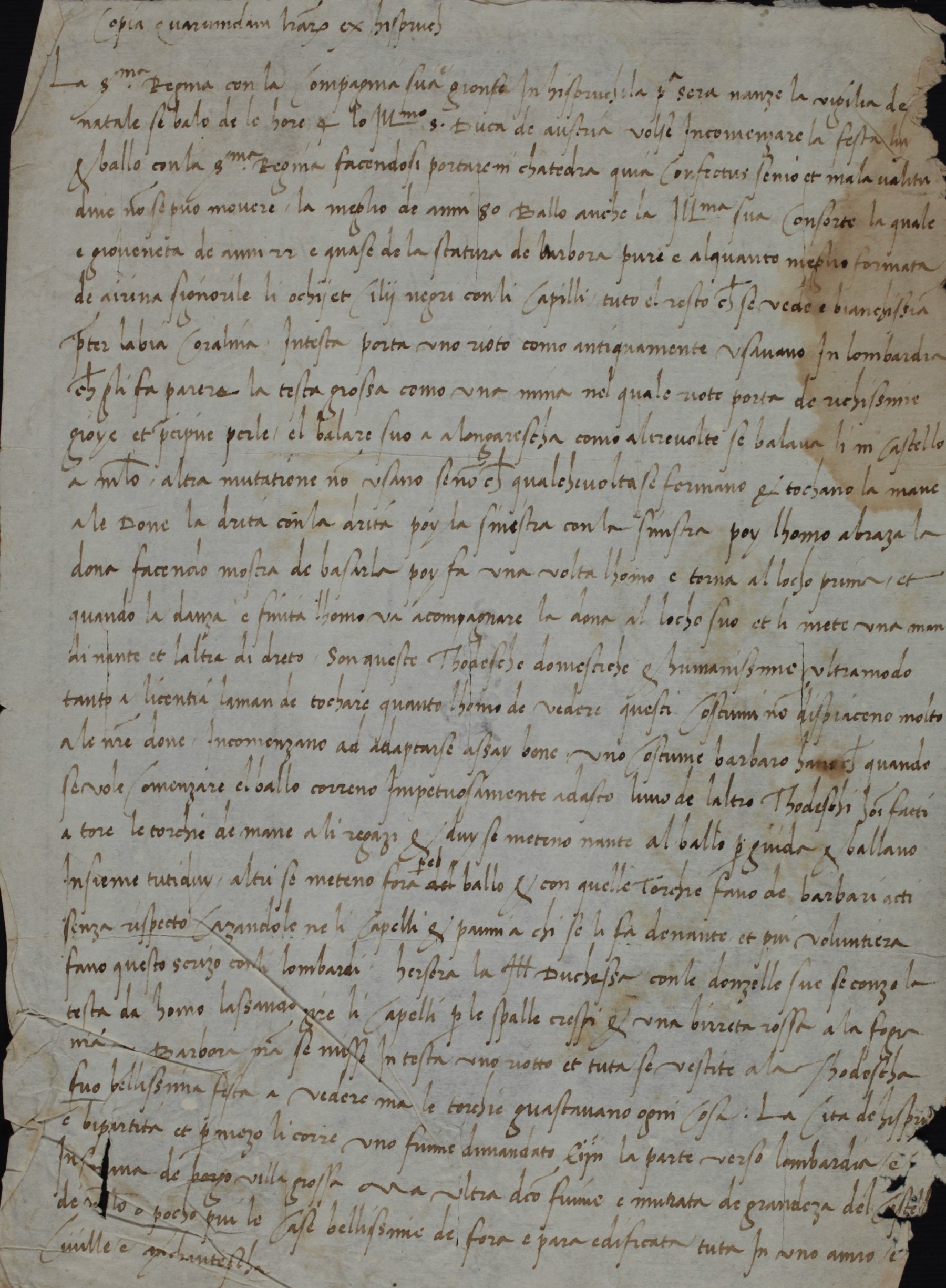The arrival of Bianca Maria Sforza
One occasion that gave rise to accounts of musical performances during the early years of Maximilian’s governance of the Tyrol, was the celebration of his marriage to Bianca Maria Sforza, daughter of Galeazzo Maria Sforza, Duke of Milan, in spring 1494. The wedding had taken place by proxy in Milan on 30 November 1493, Maximilian represented by Margrave Christoph of Baden, and now, in Innsbruck, the newlyweds would celebrate together.[29] Bianca Maria had left Italy for Innsbruck on 5 December with a large entourage, including members of her family. After making various stops en route, she arrived in Imst on 20 December where she was met, not by Maximilian, who had been detained in Vienna, but by Sigmund and his wife Katharina. From Imst she travelled to Innsbruck, arriving there on 22 December and spending Christmas with the old Duke and his young Duchess.[30]
Such a politically significant union called for the fullest possible display of courtly entertainments as well as detailed reports of events by the envoys present. In ambassadorial correspondence of this period – normally so focussed on political matters – we therefore find regular references to the wedding celebrations, including the role of musicians therein. Reports of the Ferrarese envoys of Duke Ercole D’Este are particularly illuminating in this respect. In December 1493, for example, his ambassadors reported home on the dancing that had been held in honour of the new queen on 24 December, following her arrival in Innsbruck (see » Abb. Letter from the Ferrarese ambassadors):[31]
(The most serene queen reached Innsbruck with her entourage. The following evening, before Christmas Eve, they danced from four o’clock. His most illustrious Lordship, the Duke of Austria wanted to start the festivities and dance with the most serene queen. He was carried there in a chaise as he is elderly, in poor health and cannot move well. He is over 80 [recte 66] years old. His most illustrious consort also danced, who is a young lady of 22 [recte 25] years old and almost of a Barbaric [i.e. Germanic] stature, yet she is somewhat better formed and has a noble air, the eyes and brows black like the hair, everything else that is visible is perfect white, apart from the coralline lips. On the head she is wearing a wreath as they used to wear in Lombardy in ancient times, which makes her head appear large like a bomb, on which wreath she has the richest jewels and exquisite pearls. Their dance is the alongaresca [Hungarian dance], as is sometimes danced in the castle in Milan; they did not make any changes, except that sometimes they stop and touch hands with the ladies, the right with the right, then the left with the left, then the man embraces the lady as if to kiss her. The man then makes a turn and returns to his place. And once this dance (movement) is finished, the man accompanies the lady to her place, placing one hand in front, and the other behind her.
These German ladies are exceedingly accommodating and humane, as much for the licence of touching hands as for letting the men see; these customs do not displease our ladies much, they begin to adapt themselves very well to having a barbaric custom. When they wish to begin the dancing, the German men are running impetuously and in contest with one another, in order to tear away the torches from the boys, and two of them place themselves in front of the dance to lead, and the two dance together; others place themselves outside the dance and with these torches do gross acts without respect, making them catch hair and clothes of those in front, and preferably they do this trick to the Lombards. Yesterday evening the Illustrious Duchess with her ladies dressed their heads as men, letting their hair tumble down freely over the shoulders and wearing red berets of a wild and barbaric form; previously she had placed a face-mask on her head, and dressed herself all in the German fashion. It was a beautiful feast to see, but the torches damaged everything. The city of Innsbruck is bipartite and through the middle there runs a river called the Inn; the part towards Lombardy is in the guise of a large market town but the city across the river is walled all around the castle and somewhat beyond, the houses looking beautiful from the outside, and it all seems built in a single year, civilised and enchanting.)
[29] Weiss 2010, 56.
[30] Hochrinner 1966, 33-39.
[31] Archivio di Stato di Modena est disp amb germ, busta 1, undated letter, recto. A summary of the letter is presented in Regesta Imperii Online XIV,1 n. 2877: http://www.regesta-imperii.de/id/1493-12-24_1_0_14_1_0_2882_2877 (accessed 01.11.2019).
[1] Maximilian was elected King of the Romans in 1486. He succeeded his father, Friedrich III, as head of the House of Habsburg in 1493, but only received the title of Emperor in 1508. For clarity, he will be referred to here as king. At this time, Upper Austria (“Oberösterreich”) comprised Tyrol, parts of the Upper Rhine, East Swabia, Alsace and the Vorlande at the east end of Lake Constance: see Benecke 1982, 35; Wiesflecker-Friedhuber 1996, 131f.
[2] Benecke 1982, pp. 35-6; Wiesflecker-Friedhuber 2005, 126f.
[3] „…ihn herrlich empfienge, und unter andern Kurzweilen, zu den Tyrolischen Fundgruben führte“. Birken 1668, 1012.
[4] See, for example, Drexel 2001, 603; Höpfel 1989, 20.
[5] “Deren Gewerkleute, an der zahl 7400, unter fliegendem Fahn in schöner ordnung, ihnen entgegen kamen, und nach des Erzherzogen befehl, vor dem Röm. König sich auf die kniehe warfen.” Birken 1668, 1012f.
[6] “Sie brachten ihm auch Geschenke, etliche güldene Schüsseln voll Rheinischer Goldgulden, und ungearbeitetes Silber bey 100 Pfunde. Es kamen auch Venedische Gesandten, die ihn, mit Widergabe etlicher dem Erzhaus vordessen abgenommenen Plätze, zu versöhnen begehrten: weil sie vernommen hatten, daß sie ihn forthin zum Nachbarn haben würden.“ Birken 1668, 1012f.
[7] “Rhætica dum tellus vult se summittere Summo Æmilio, fossor prævius ecce venit. Aurea, se talem tali probat, illa, ministro: hinc auro plenas obtulit iste manûs.” Birken 1668, 1013. I would like to thank Alison Samuels for the translation of this epigram and James Robson for further advice about its meaning.
[8] “Tyrol sein Bergleut-Heer dem Helden schickt entgegen, itzt da es selbst sich will zu dessen füssen legen. Es heiset ihn willkomm durch Gold in ihrer Hand: Weil es, durch ihren Fleis, sich weist ein güldnes Land.” Birken 1668, 1012.
[9] “Aber Erzh. Sigmund, der nun ein hohes Alter auf sich, und keinen Leibs Erben mehr zuhoffen hatte, auch zu den Regirungssorgen verdrossen war, beschickte seine Landstände nach Insbruck, sprache sie ledig von ihrer Eidspflicht, und hiesse sie dem Röm. König, als ihrem angehenden Landsfürsten, schwören, den er, in ihrer gegenwart, an Sohns stat aufnahme, ihm alle von Vatter ererbte Länder abtratte und übergabe…” Birken 1668, 1013.
[10] Wiesflecker-Friedhuber 2005, 128. See also Jäger 1874.
[11] Drexel 2001, 602-3; Senn 1954, 1-2.
[12] For the Mitterhof, see » Leitbild F. with commentary. Further details of Maximilian’s relationship with Innsbruck are in Senn 1954, 19; Fritz 1968; Cuyler 1973; Benecke 1982; Wiesflecker-Friedhuber 1996 and 2005.
[13] Felix Faber (1923, 33): “In dieselbe [Innsbruck] eingetreten, fanden wir sie voll von Adeligen und Bewaffneten. Fürsten, Grafen und Barone waren zum Erzherzog gekommen, denn gerade feierte der Landesfürst mit der Tochter des Sachsenherzogs Hochzeit; zu dieser Feier war der Adel aus ganz Deutschland zusammengeströmt.”
[17] A tun of wine was awarded to the organist in January 1498: see Wiesflecker 1993, 269 (no. 5756).
[18] Wiesflecker 1993, p. 222 (no. 5364).
[19] Busch-Salmen 1992, pp. 64f.; Schuler 1995, 13.
[20] See also » I. The court chapel of Maximilian I.
[22] The Triumphzug was never completed, and its woodcut images therefore include a number of empty banners, which were to contain phrases introducing many of the personnel presented. However, the intended content of the plaques can be reconstructed from the initial manuscript programme for the images, which was dictated by Maximilian himself and refers to several musicians by name.
[24] For example, the Augsburg civic accounts of 1490 include payment of: “4 fl. des kunigs zwayen luttenschlager, Artus vnd Lenhart”. D-Asa (Stadtarchiv Augsburg), Baumeisterbücher Nr. 84 (1490), fol. 17r.
[28] Wiesflecker 1971-1986, vol. 5, 401-2.
[29] Weiss 2010, 56.
[30] Hochrinner 1966, 33-39.
[31] Archivio di Stato di Modena est disp amb germ, busta 1, undated letter, recto. A summary of the letter is presented in Regesta Imperii Online XIV,1 n. 2877: http://www.regesta-imperii.de/id/1493-12-24_1_0_14_1_0_2882_2877 (accessed 01.11.2019).
[32] Archivio di Stato di Modena est disp amb germ, busta 1, undated letter, verso. A summary of the letter is presented in Regesta Imperii Online XIV,1 n. 2877: http://www.regesta-imperii.de/id/1493-12-24_1_0_14_1_0_2882_2877 (accessed 01.11.2019). Dances at Maximilian’s court will be discussed further in » I. Civic and courtly dancing.
[33] „parte in ballare e parte in videre zugare la prefata Domina Archiducesa con alchuni altri Signori et cavaleri de li suoi et de li nostri. E queste feste qualchi volta sono facte in publico, et qualchi volta privatamente ne la camera nostra.“ Calvi 1888, 48.
[34] Tiroler Landesarchiv Innsbruck (A-Ila), Maximiliana XIV/1493, fol. 103. Summary in Regesta Imperii Online,
RI XIV,1 n. 2878: http://www.regesta-imperii.de/id/1493-12-24_2_0_14_1_0_2883_2878 (accessed 01.11.2019).
[35] Quoted in: Köfler and Caramelle 1982, 208.
[37] Regesta Imperii XIV Nr. 25967: Archivio di Stato di Mantova, Agonz, E/II/2, busta 429, Nr 6.
[38] Waldner 1897/98, 11.
[39] Waldner 1897/98, 14.
[41] Hochrinner 1966, 44.
[42] Pandolfo Collenuccio, Innsbruck, to Ercole d’Este, 18 March 1494: Archivio di Stato di Modena dis amb germ, busta 1, recto. Summary of the letter in: Regesta Imperii Online, RI XIV,1 n. 478: http://www.regesta-imperii.de/id/1494-03-16_1_0_14_1_0_482_478. See also Wiesflecker Bd. I, 368.
[43] This was Perkin Warbeck, pretender to the English throne, who claimed to be Richard, Duke of York, the missing second son of Edward IV.
[44] See Green 2012; Grassl 2019.
[46] Quoted in Meconi 2003, 27.
[47] Further on Maximilian’s chapel singers, see » I. The court chapel of Maximilian I.
[48] Waldner 1897/98, 20-21.
[49] Senn 1954, 39–44; See also Waldner 1897/98, 33–34.
[53] D-Asa (Stadtarchiv Augsburg), Baumeisterbücher Nr. 101 (1507), fol. 24v and Nr. 102 (1508), fol. 24v.
[55] Indeed, from 1516 until 1521, the two young princesses Anna of Hungary and Maria of Austria were resident at the Innsbruck palace and had several musicians in their employ. See Waldner 1897/98, 59 and Senn 1954, 46–47.
[56] Gachard 1876, 309.
[57] Gachard 1876, 310.
[58] Senn 1954, 39-40, also regarding the subsequent repair of the organ by Balthasar Streng in 1502.
[60] Gachard 1876, 319.
[61] Gachard 1876, 311.
[62] Gachard 1876, 315.
[63] Meconi 2003, 62.
[64] Gachard 1876, 313.
[65] Gachard 1876, 316–317.
[66] D-Asa (Stadtarchiv Augsburg), Baumeisterbücher Nr. 97 (1503), fol. 28r and Nr. 98 (1504), fol. 26r-v.
[67] Wessely 1956, 111.
[68] Meconi 2003, 35. See » I. Instrumentalkünstler; » G. Augustin Schubinger.
[69] Gachard 1876, 314.
[70] Gachard 1876, 320.
[71] Sanuto’s diaries are published in Barozzi 1880.
[72] Barozzi 1880, column 217.
[73] Barozzi 1880, column 216.
[74] Barozzi 1880, column 215.
[75] According to Benecke 1982, 94, Maximilian visited Innsbruck 22 times between 1498 and 1518.
Empfohlene Zitierweise:
Helen Coffey: „Music and ceremony in Maximilian’s Innsbruck“, in: Musikleben des Spätmittelalters in der Region Österreich <https://musical-life.net/essays/music-and-ceremony-maximilians-innsbruck> (2019).

